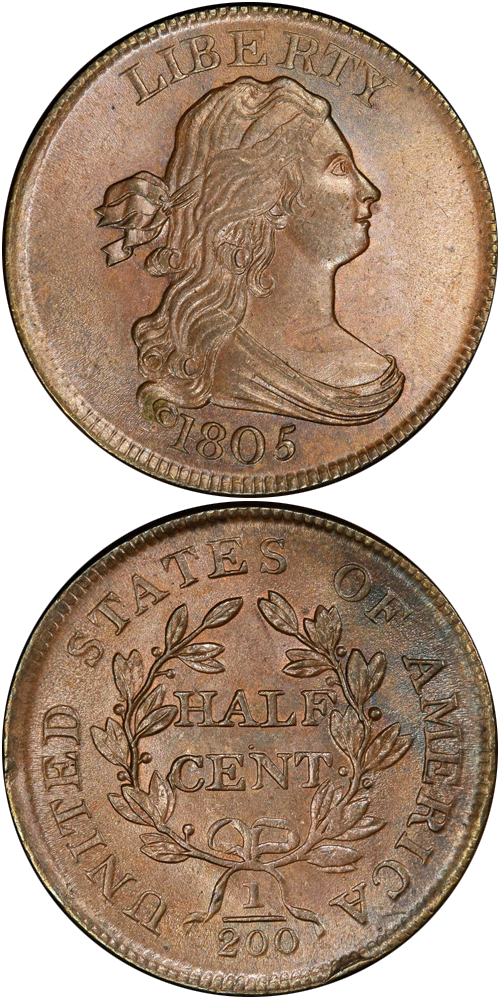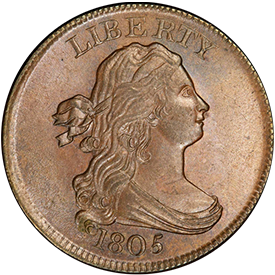Designed by: Robert Scot
Issue Dates: 1800-1808
Composition: Copper
Diameter: 23.5 mm
Weight: 5.44 grams (84 grains)
Edge: Plain
Business Strike Mintage: 3,416,950
Proof Mintage: None
The Draped Bust obverse, earlier used on silver dollars beginning in 1795 and on certain other early denominations beginning in 1796, did not appear on the half cent until 1800. Undoubtedly it would have appeared earlier had coinage of half cents not been suspended during the 1798-1799 years. The obverse depicts Miss Liberty facing right, with flowing hair and a ribbon behind her head, her plunging neckline covered with drapery. LIBERTY is above, and the date is below. The reverse comprises an open wreath enclosing HALF CENT, with UNITED STATES OF AMERICA and 1/200 around the border. The edges of these and all later half cents are plain.
Produced in relatively large quantities for the time, half cents of the 1800-1808 years are easy to find today, particularly in the normally encountered grades of Good through Very Fine. Extremely Fine coins are scarce, though not rare, and even AU pieces can be acquired without difficulty. Uncirculated coins are quite elusive and usually are of the dates 1804 or 1806, particularly the latter, for small hoards of these dates turned up many years ago.
In keeping with other coinage of the era, striking was apt to be casual at best, with the result that specimens may have some areas of weakness. The planchet quality was considerably improved from the half cents of an earlier era, with the result that without difficulty you can acquire a coin with smooth surfaces. The coloration of a typical half cent of the era is often light, medium, or dark brown. There are many individual differences.
Further Reading
Following a two-year hiatus, half cents were again minted in 1800. The Draped Bust style used on large cents of 1796 was adopted. The obverse features Miss Liberty with ample hair tied behind her head with a ribbon and with additional tresses reaching her shoulders. Whereas the previous style showed Miss Liberty only from the neck up, the new style terminated with her draped bosom. The liberty cap, a fixture since 1793, was dropped. The Draped Bust was the work of artist Gilbert Stuart and first appeared on the 1795 silver dollar.
Mint records indicate that 211,530 half cents were coined in 1800, but it may be the case that several thousand of these were from earlier dies and were dated 1797. Among the sources of copper were prepared planchets ordered from the establishment of Boulton & Watt in Birmingham, England, which arrived on April 19, 1800, on the sailing ship Pomona, a quantity amounting to 186,886 planchets housed in six wooden casks. Additional copper was provided by "spoiled" large cents, mis-struck examples from which half cent planchets were cut.
Among half cents of the 1800-1808 design only two dates are regularly seen in Uncirculated grade, 1800 and 1806. Examples in Mint State apparently trace their origins to a hoard of a few hundred pieces of each date distributed by the Chapman brothers, Philadelphia dealers, around the turn of the twentieth century. To a lesser extent, half cents of 1804 are encountered in Uncirculated condition.
1802 half cents were made in two die varieties. Each was struck from the same obverse die, actually an overdate, 1802/0. The reverse dies are different. The earlier, the so-called Reverse of 1800 variety, is distinguished by having one leaf to each side of the wreath apex. The same die enjoyed a very long coinage life and was used to produce approximately 200,000 coins two years earlier (no half cents having been made in 1801). This variety is exceedingly rare. Fewer than 20 specimens exist, nearly all of which are well worn. The best seen by Walter Breen grades just Fine.
The second and most often seen variety is that with the "regular" reverse, or the reverse of 1802, with one leaf to the left of the wreath apex and two leaves (overlapping and resembling a lobster claw) to the right. The Mint report of 14,366 half cents coined for 1802 indicates that as a date this year is rare, and this is verified by the scarcity of specimens on the market.
It is believed that all 1802 half cents were struck on planchets cut from what Mint records refer to as "spoiled" large cents-pieces that were struck off-center, or that had clips in the edges, or other problems. Evidently the Mint kept mis-struck large cents on hand for several years, for I once owned an 1802 half cent which was struck on a planchet made from a 1798 cent, on which the 1798 date was quite prominent. Occasionally 1802 half cents seen today display evidences of the large cent undertype design. Most 1802 half cents are deep brown, or even black, and exhibit surface porosity. Most known specimens of this date are in the lower range of grades, from Good to Fine. Very Fine pieces are scarce, Extremely Fine pieces are rare, and, as far as I know, no Uncirculated specimens exist.
Nearly 100,000 1803 half cents were coined. Four different die varieties are known, differing from each other by minor variances in the placement of the features. Although readily available in grades from Fine through Extremely Fine and even AU, Uncirculated 1803 half cents are rarities.
A comparison of half cents of 1800 with those of 1803 furnishes an interesting example of rarity as applied to different grades. In worn grades (less than Uncirculated) both are seen often in the marketplace, with the 1800 being slightly more common in keeping with its greater mintage. However, in Mint State there is a vast difference. While I have handled dozens and dozens of Uncirculated 1800 half cents over the years, pieces which probably trace their pedigree to the Chapman hoard, I have never seen an 1803 example with original mint red color.
Half cents of the following year, 1804, are characterized by a number of interesting varieties, primarily characterized by whether or not a particular piece has a plain crossbar to the 4 or a crosslet, or whether or not the wreath has stems.
One of the most curious 1804 varieties is the famed Spiked Chin, on which Miss Liberty has a prominent thornlike spike protruding from her chin. The origin of this feature is not known and has been variously attributed to a slip of an engraver's chisel (the engraver may have been touching up the die), or a grinding mark incurred after the die was first prepared (the Spiked Chin was earlier used in its perfect state to strike half cents that did not include this feature; the die evidently was hardened for future use and may have been reground during this period, at which time the "spike" may have occurred).
Half cents of 1804 are readily encountered in grades up to Extremely Fine and AU, but Uncirculated pieces with original mint red must be classified as rarities. The major varieties of 1804 can be divided into five groups: plain 4, stems; plain 4, stemless; crosslet 4, stems; crosslet 4, stemless; and the Spiked Chin. Total mintage for the year was slightly more than one million pieces, a new high for the denomination.
Mint reports indicate that 814,464 half cents were struck in 1805, but a number of these may have been dated 1804. Roger Cohen suggests that some pieces dated 1803 may also have been struck during the 1805 calendar year. In early times it was the Mint practice to keep earlier-dated dies on hand and to use them until they were no longer fit for service. Sometimes such dies were overdated to reflect the current year of coinage, but in other instances they were simply used with the earlier digits.
In popular literature 1805 cents are divided into three main varieties: small 5, stemless; small 5, stems; and large 5, stems. The small 5, stems variety is quite scarce and the most famous. Actually, the distinction between "large" and "small" 5 of this year is not very precise, for the 5 in the "large" date is also quite small. Perhaps Roger Cohen described the difference more precisely when he noted the regular 5 is small and the "small" 5 is extremely small. In any event, this variety has been confusing collectors for many years.
In keeping with several other dates in its range, the 1805 is readily seen in conditions up to and including Extremely Fine and AU but is a rarity in Uncirculated grade.
The 1806 half cents occur in large and small 6 varieties, both with and without stems to the wreath on the reverse. In this instance the difference between the sizes of the 6 in the date is more distinctive, but not outstandingly so. The Small 6 with Stems variety is considerably scarcer than the others.
Uncirculated specimens of the Large 6 with Stems variety are seen with some frequency and are believed to trace their ancestry to the previously-mentioned group distributed by the Chapman brothers around the turn of the century. Over the years most dealers and others who have come across hoards of various coins of one type or another have let the pieces trickle out into the numismatic marketplace. Only in rare instances has full disclosure of such hoards been made. As a result, the quantities of such groupings are often a matter of conjecture and are pieced together by circumstantial evidence.
The 1807 half cents, for which the Mint reported a coinage of 476,000 pieces (a figure which may have included some dated 1806), were apparently minted from a single pair of dies. That a second obverse die was on hand, but not used in 1807, is illustrated by an overdate produced the following year, the 1808/7.
In grades up to Extremely Fine the 1807 is plentiful. AU pieces are elusive, and Uncirculated examples are great rarities. Here is another example of a piece which is common enough in lower grades but which is virtually unknown in Mint State. Around 1970 I acquired an Uncirculated piece as part of the Litchfield Collection. My enthusiasm for the piece was questioned by a client who wondered why I was making such a fuss over a piece which had only a nominal catalogue value. However, in the years since then I haven’t handled another!
The last year of the Draped Bust half cents is 1808. An overdate variety, 1808/7, was made by overpunching an unused 1807 die. This variety is fairly scarce in all grades and is a major rarity in Extremely Fine or better. Although 400,000 1808 half cents were made, apparently only a handful escaped the channels of commerce, for while normal (nonoverdate) pieces are seen frequently in lower grades today, Uncirculated specimens are major rarities.
For the type set collector the 1800-1808 style presents no strong challenge. The variety collector will find the search for different date numeral and stem varieties interesting. Using Fine to Extremely Fine as a condition objective, the only great rarity among major varieties is the 1802 with the reverse die of 1800.







